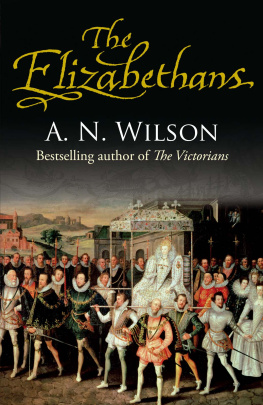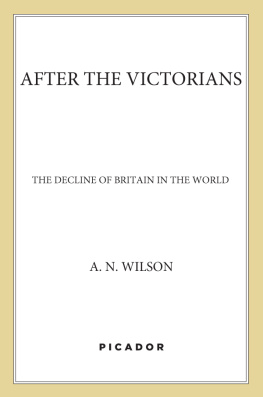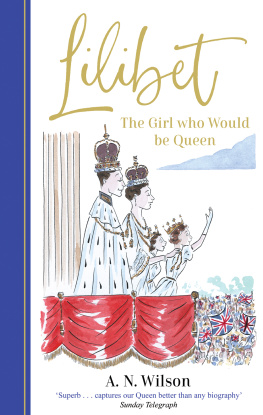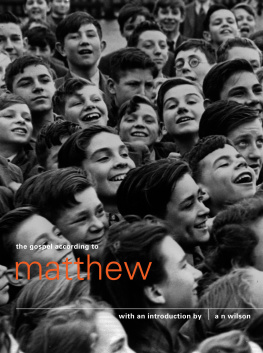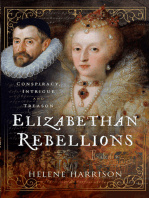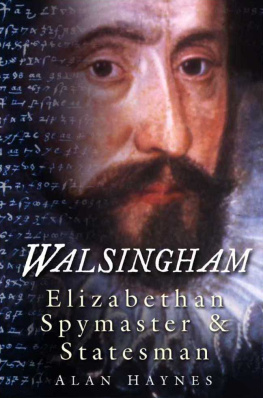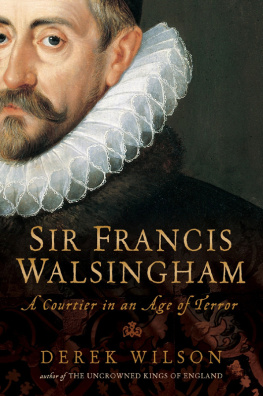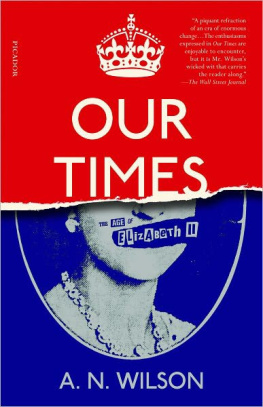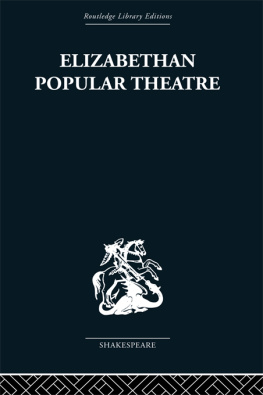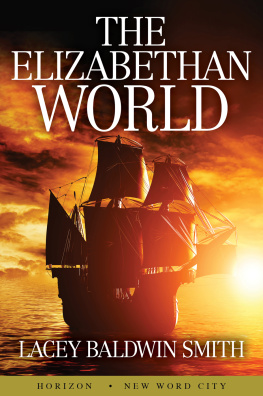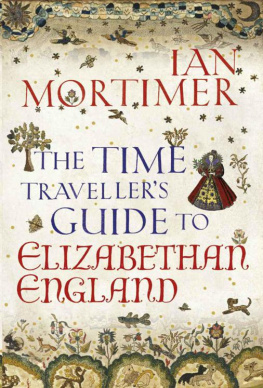Contents
Essex and the End
Also by A. N. Wilson
FICTION
The Sweets of Pimlico
Unguarded Hours
Kindly Light
The Healing Art
Who Was Oswald Fish?
Wise Virgin
Scandal
Gentlemen in England
Love Unknown
Stray
The Vicar of Sorrows
Dream Children
My Name is Legion
A Jealous Ghost
Winnie & Wolf
The Lampitt Chronicles
Incline Our Hearts
A Bottle in the Smoke
Daughters of Albion
Hearing Voices
A Watch in the Night
NON-FICTION
A Life of Walter Scott
A Life of John Milton
Hilaire Belloc
Penfriends from Porlock
Tolstoy
C.S. Lewis: A Biography
The Rise and Fall of the House of Windsor
Gods Funeral
The Victorians
Iris Murdoch As I Knew Her
London: A Short History
After the Victorians
Betjeman
Our Times
Dante in Love
The Elizabethans
A.N. Wilson

for
KATHERINE DUNCAN-JONES,
Elizabethan sans pareil
This ebook is copyright material and must not be copied, reproduced, transferred, distributed, leased, licensed or publicly performed or used in any way except as specifically permitted in writing by the publishers, as allowed under the terms and conditions under which it was purchased or as strictly permitted by applicable copyright law. Any unauthorised distribution or use of this text may be a direct infringement of the authors and publishers rights and those responsible may be liable in law accordingly.
Epub ISBN: 9781409038276
Version 1.0
www.randomhouse.co.uk
Published by Hutchinson 2011
2 4 6 8 10 9 7 5 3 1
Copyright A.N. Wilson 2011
A.N. Wilson has asserted his right under the Copyright, Designs and Patents Act 1988 to be identified as the author of this work
This book is a work of non-fiction.
First published in Great Britain in 2011 by Hutchinson
Random House, 20 Vauxhall Bridge Road,
London SW1V 2SA
www.rbooks.co.uk
Addresses for companies within The Random House Group Limited can be found at: www.randomhouse.co.uk/offices.htm
The Random House Group Limited Reg. No. 954009
A CIP catalogue record for this book is available from the British Library
ISBN 9780091931513
Acknowledgements
Gillon Aitken was the onlie begetter of this book. It was his idea that I should write it, and I am deeply grateful for all his encouragement, with this and other projects, and for his friendship over many years. Many thanks, too, to Emma Mitchell, Paul Sidey, Mandy Greenfield and George Capel who all gave support and advice. Thanks to Simon Thurley, Anna Keay, David Starkey, and Roy Strong, all experts in a field where I am an amateur, who guided my steps and suggested further reading. Georgie Wilson helped with Elizabethan Highgate and with the Armada chapter, and Ruth Guilding with the architecture. I finished the book at Lamorna Cove, Ruths brainchild, looking at the sea and imagining the Armada sailing by. My greatest debt, in writing this book and in understanding many others, is expressed in the dedication.
Oak Apple Day, 2011
About the Book
With all the panoramic sweep of his bestselling study The Victorians, A. N. Wilson relates the exhilarating story of the Elizabethan Age. It was a time of exceptional creativity, wealth creation and political expansion.
It was also a period of English history more remarkable than any other for the technicolour personalities of its leading participants.
Apart from the complex character of the Virgin Queen herself, we follow the story of Francis Drake and political intriguers like William Cecil and Francis Walsingham, so important to a monarch who often made a key strategy out of her indecisiveness. Favourites like Leicester and Essex skated very close to the edge as far as Elizabeths affections were concerned, and Essex made a big mistake when he led a rebellion against the crown.
There was a Renaissance during this period in the world of words, which included the all-round hero and literary genius, Sir Philip Sidney, playwright-spy Christopher Marlowe and that myriad-minded man, William Shakespeare.
Life in Elizabethan England could be very harsh. Plague swept the land. And the poor received little assistance from the State. Thumbscrews and the rack could be the grim prelude to the executioners block. But crucially, this was the age when modern Britain was born, and established independence from mainland Europe. After Sir Walter Raleigh established the colony of Virginia, English was destined to become the language of the great globe itself, and the the foundations were laid not only of later British imperial power but also of American domination of the world.
With The Elizabethans, Wilson reveals himself again as the master of the definitive, single-volume study.
About the Author
A. N. Wilson was born in 1950 and educated at Rugby and New College, Oxford. A Fellow of the Royal Society of Literature, he holds a prominent position in the world of literature and journalism. He is an award-winning biographer and a celebrated novelist, winning prizes for much of his work. He lives in North London.
List of illustrations and credits
Elizabeth I, The Ditchley Portrait, by Marcus Gheeraerts the Younger, c.1592. National Portrait Gallery, London: NPG 2561
An Allegory of the Tudor Succession: The Family of Henry VIII, c.158995 (oil on panel), English School, (16th century) / Yale Center for British Art, Paul Mellon Collection, USA / The Bridgeman Art Library
Sir Francis Walsingham c.15321590 English statesman and spymaster for Queen Elizabeth I. From the book Lodges British Portraits published in London, 1823. (Photo by Universal History Archive/Getty Images) Getty Images
William Cecil, 1st Baron Burghley (152098) English statesman. Lord High Treasurer to Elizabeth I from 1572. Engraving. (Photo by Universal History Archive/Getty Images) Getty Images
G.11631.B.L. Title Page with a Portrait of Shakespeare, from Mr. William Shakespeares Comedies, Histories and Tragedies, edited by J. Heminge and H. Condell, engraving by Droeshout, 1623 (engraving) British Library Board. All Rights Reserved
Interior of schoolroom where William Shakespeare was educated, Stratford-upon-Avon, Warwickshire, England, UK, Europe Peter Scholey
Mary Herbert Countess of Pembroke, nee Mary Sidney, 15611621. English patroness of the arts and translator. From the book Lodges British Portraits published London 1823. (Photo by Universal History Archive/Getty Images) Getty Images
Circa 1590, English poet Edmund Spenser (c. 15521599). With Sir Philip Sidney and Dyer, he formed the literary club Areopagus, and invented the Spenserian stanza in poetry. Original Artwork: Engraving by Thomson. (Photo by Archive Photos/Getty Images) Getty Images
Robert Dudley (153288) 1st Earl of Leicester, c.1560s (oil on panel), Meulen, or Muelen, Steven van der (fl.154368) / Yale Center for British Art, Paul Mellon Collection, USA / The Bridgeman Art Library
Kenilworth Castle, Warwickshire, England David Hughes
Portrait of Sir Francis Drake (15401596) 1591 (oil on panel) Marcus Gheeraerts the Younger
Portrait of British Naval commander Sir John Hawkins. (Photo by Time Life Pictures/Mansell/Time Life Pictures/Getty Images) Time & Life Pictures/Getty Images
Circa 1600, A naval and military battle in which the English fleet engages the Spanish Armada at Cadiz. (Photo by Hulton Archive/Getty Images) Getty Images
Circa 1570, English poet, courtier and soldier Sir Philip Sidney (15541586) who typified the Elizabethan gentleman. Original Artwork: Engraved by E Scriven. (Photo by Hulton Archive/Getty Images) Getty Images
Next page
